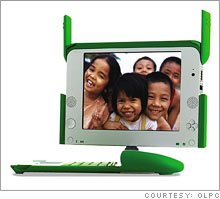Tech targets the Third WorldMaking sophisticated products cheaply and in huge numbers is how the giants hope to grow.NEW YORK (Fortune) -- Carly Fiorina may have gotten some things wrong when she was CEO of Hewlett-Packard, but she did show an admirably early understanding of one of the most important trends in tech. Back as far as 1999, she was championing something HP called World e-Inclusion, a program to focus the company's resources on creating products and services for the world's poor and developing nations. Today, efforts like that are top of mind at many of the biggest technology companies. AMD, Cisco, Google (Charts), IBM (Charts), Intel (Charts), Microsoft (Charts), Motorola, Nokia and Sun, among others, are resolutely focused on the opportunities presented by the developing world. They are interested because of a wonderful combination of social concern and greed.
This is the largest market any of these companies have ever seen - the first ever whose size can be routinely measured in billions of people. The entire world is hungry for technology. I recently had the privilege to give a speech on technology and the developing world to a group at the United Nations in New York. In the speech I enumerate many specific initiatives big tech companies have launched. (Ironically, Fiorina's successor at HP Mark Hurd seems to have deep-sixed the e-Inclusion work.) Americans too often talk about the tech industry as if it primarily transacted its business here. But the biggest companies see it otherwise. They need growth, and realize it can be had helping the poor. The logic is simple - if you provide the poor with tools that increase their earning power, they will be able to earn more and pay you for those tools. The appetite for tech is striking in countries around the world, even in places you might not expect. I recently asked Paul Mountford, Cisco's (Charts) head of emerging markets, if there were any new countries he had encountered that were aiming to use IT to speed up growth in the way that Korea, Taiwan and Singapore have done in recent decades. He said the first country that came to his mind was Libya. The cellphone is by far the most important tool for connection in developing countries. There are an estimated 1.5 billion cellphones now in use in the developing world. That figure will grow to at least 3 billion over the next five years. In India alone, 5 million new customers sign up for cellphones every week. More than 80 percent of the world's population, calculates Motorola, already lives in an area covered by wireless networks. People are starting to talk about owning a cellphone as a basic human right. And cellphones in the developing world are generally used heavily for the micro-businesses that so many individuals and families there maintain. Motorola (Charts) already has many millions of orders for its new Motofone, built specifically for emerging markets. Even slimmer than the celebrated RAZR, it will sell for around $30. Motofone gets up to 400 hours of standby time on one battery charge, enabling its use in environments where electricity is scarce. It uses a very large screen that works in reflected light, using no internal lamps, specially enabled for text messaging. (Short text messages are even more important in developing economies than they are in developed ones.) The Motofone also illustrates how the poorest markets are increasingly served with the most sophisticated high technology. To make Motofone both simple and cheap enough, Motorola had to apply state-of-the art design and electronics. The business strategist C.K. Prahalad has had a huge impact in the tech industry with his book "The Fortune at the Bottom of the Pyramid." It explains, among other things, how products made for developing countries can prove tremendously valuable in developed ones as well. You are likely to want a Motofone. But technologies like this will appear first in the developing world, and only later penetrate places like the United States. Another example is the so-called $100 laptop for students in developing countries championed by Nicholas Negroponte of MIT's Media Lab. Negroponte's team has made breakthroughs in the screen, power source and physical design, among other things. People will salivate for it in the United States and Europe even as it gets launched next year in Latin America, Africa and rural Asia. This trend will continue the profoundly anti-inflationary global impact of the tech industry, whose products typically get cheaper even as they improve. (For instance, the newest iPod shuffle holds 240 songs and costs $80, but replaced one that held 120 songs for $100.) In coming years we will see an explosion of new technologies for broadband, for mobile computing, for education and health care - and the first place in the world many of these will take root will be in developing countries where there is no legacy system problem, no installed base, just a huge mass of eager people. The next five years will begin a golden era for technology to empower the poor. |
Sponsors
| |||||||||||||

